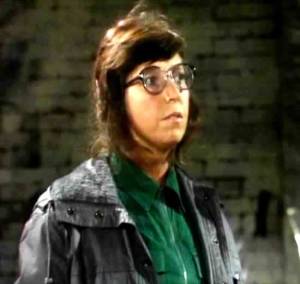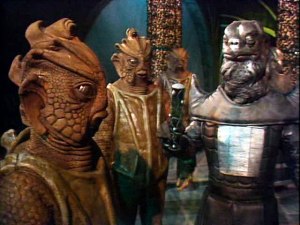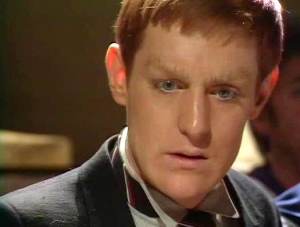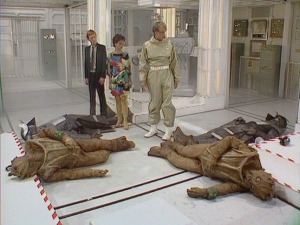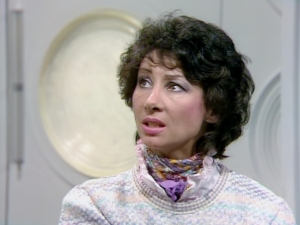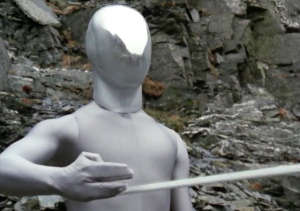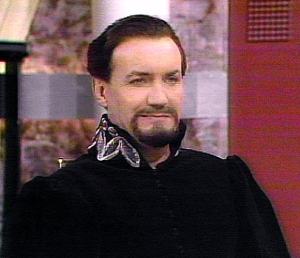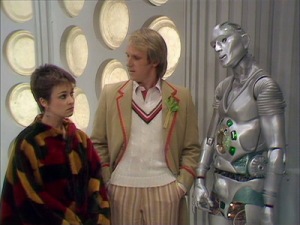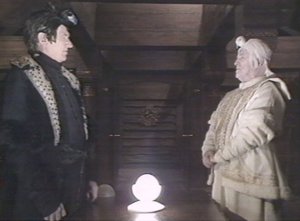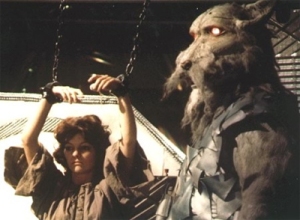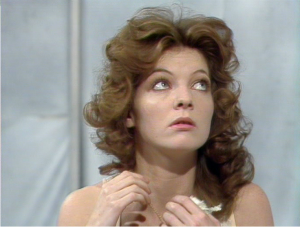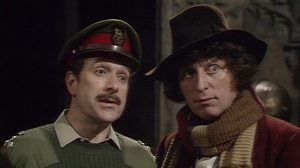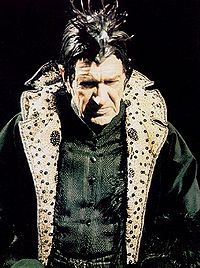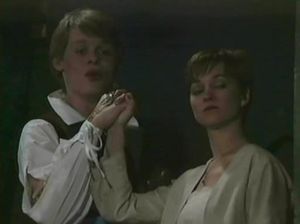And a good afternoon to you, faithful viewer! Thanks so much for joining me today (especially since you’ve had to tear yourself away from the new Avengers movie to do so), because we’ve got a doozy of a serial this time. Truly innovative sci-fi which will make us question the very foundations of our society, yes!
Just kidding. It’s just another story that asks the question: What else can the Daleks do to come across as massive intergalactic nuisances. Still, should be a good time, eh?
This one definitely starts off with a bang, in any case. As an American, I understand that police shootouts are quite rare on London streets, but that’s exactly what happens within the first two minutes of the first episode. Fortunately, this shootout didn’t actually involve any police (which I believe would’ve been grounds for one hell of a tribunal). Instead of any human police, the shootout involved a pair of warring alien factions, duking it out over possession of a very valuable POW: Davros. In the middle of this action, the Doctor gets pulled to twentieth-century London via a Time Corridor created by the Daleks. All of time and space to choose from, and we always seem to end up in modern-day England. Ho-hum. Evidently, Davros has plans for the Doctor, and none of them are remotely cuddly. Using advanced cloning technology, Davros plans to create copies of the Doctor and his companions and then assassinate the High Council of Gallifrey–the fiend! With so much at stake, the Doctor is pitted against his oldest nemeses, the Daleks, once again.
I’ll talk about the serial itself in a second, but first I’d like to address the weirdness of the episode format in this story. Due to an important sportsball event happening at the time (okay, it was the 1984 Olympics), the traditional 4-part 25-minute episode format was scrapped in favor of a 2-part 45-minute episode deal when it was broadcast. In the years that followed, the serial was reconstructed in the traditional format. I wanted to watch the 2-parter, but unfortunately I couldn’t find it in time to post this recap. I wish I had–I think the longer-episode format might have been easier to follow.
Getting into the story itself, I have to say that the direction this time was some next-level stuff. It was Matthew Robinson behind the camera this time, and as a result, we had beautifully moody tracking shots and an epic sense of depth and scope to the whole thing. Tired story or not, it sure was fun to watch.

Photo credit, http://www.dvdactive.com
Plot-wise, as I say, it was all a bit piecemeal. I don’t think it was ever explained why Davros wanted to go to 20th century London, and I can’t think of a good reason why he would, other than “it was the cheapest option, filming-wise.” And overall, the whole thing just felt like an excuse to get the Doctor and Davros to fight. Which I guess is the point of the story anyway, but I’d like it better if it wasn’t quite so obvious.
As far as characters go, we did have a couple of standouts. First, a professor called Laird, who was a rarity among female minor characters in that she had actual constructive dialogue with other characters, rather than being reduced to repeating plotlines, screaming at monsters, and being consoled by everyone. As it was, I wish she’d been given more screentime–she was the most engaging lady we’ve had on the show since Romana.
And the other standout was a man called Stein. At first glance, he’s a sweet, if slightly cowardly, victim of the Dalek invaders. As the story unfolds and we find out how deeply the Daleks messed up this man, Stein magically transforms into one of the most tragic characters we’ve had on the show for quite some time. I won’t go too deeply into details, but I do think that turning Stein into a 21st-century-style Dalek puppet might have been a kinder fate than the one he met in this story.
Speaking of Dalek puppets: the Daleks’ newest method of enslaving sentient beings rears its ugly eyestalk in this serial. We’ve seen this sort of thing before (remember the Robo-Men in “The Dalek Invasion of Earth”) and we’ll see it again (the grotesque Dalek puppets in “Asylum of the Daleks”). In this serial, we get to see what I think is the missing link between the two methods. It’s kind of cool, in a perverse way, to watch the Daleks’ evilness flourish like a disgusting blossom. But of course, it’s even cooler to watch the Doctor and his companions take them down time and time again.

Photo credit, http://www.theguardian.com
Unfortunately, it looks like this serial will be the last to include Tegan as a companion–for real this time. She’s had enough of the fighting and killing that seems to follow the Doctor wherever he goes, and I can’t honestly say I blame her for calling it quits. She lost her aunt and nearly her cousin’s best friend, she saw Adric die and got creeped on by Turlough (you know, back when he was evil), she saw everyone die in “Warriors of the Deep,” and nearly got sacrificed in “The Awakening.” That’s a lot for anyone to take, even Brave-Heart-Tegan.

Photo credit, http://www.gamesradar.com
But she’s home and safe now, and the Doctor’s gone on without her. So, farewell to Tegan Jovanka. She wasn’t everyone’s favorite, but she was always indelibly herself.
Stay tuned ’til next time, faithful viewer, when we meet a new companion, battle an old enemy, and finally find out what the heck is up with Turlough…



